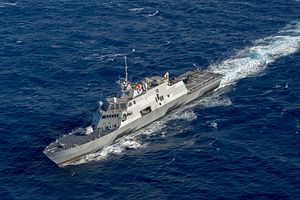The Littoral Combat Ship (LCS) USS Fort Worth has been sidelined for an unspecified period of time due to damage sustained in the vessel’s propulsion system, USNI News reports.
The LCS “experienced a casualty to the ship’s combining gears during an in-port period in Singapore Jan. 12,” Lieutenant Commander Matt Knight, a spokesman for the U.S. Pacific Fleet, said in an interview with USNI News. The combining gear “links the output of the ships’ Rolls Royce MT-30 gas turbine engines with its Colt-Pielstick diesel engines and then to the ship’s shafts that drive the water jets,” the article explains.
“Based on initial indications, the casualty occurred due to an apparent failure to follow procedures during an operational test of the port and starboard main propulsion diesel engines,” according to Knight.
“During startup of the main propulsion diesel engines, lube oil was not supplied to the ship’s combining gears,” a U.S. Navy memo obtained by Bloomberg News details. This “resulted in high-temperature alarms on the port and starboard combining gears.”
“An investigation is underway to examine the incident in depth and determine any necessary corrective action. A team of technical specialists is currently on board Fort Worth to evaluate the gears and required repairs. There is no estimated date of completion at this time,” according to Knight.
The incident comes a month after another LCS, the USS Milwaukee, also suffered from a combining gear casualty about 64 kilometers (40 miles) off the Virginia coast on December 11 during an Atlantic transit. However, Knight states that it is “unlikely that these casualties are related.” Both the USS Milwaukee and USS Fort Worth belong to the Freedom-class of LCSs.
The 389-foot (119 meter) USS Fort Worth, is only the second LCS to be deployed to the Asia-Pacific region, where it has been patrolling Southeast and Northeast Asian waters for the past year. By 2018 at the latest, the United States Navy plans to rotationally station four LCSs (one at a time) in Singapore.
As I reported previously, the 3,000-plus-ton Littoral Combat Ships of the Freedom and Independence classes are specifically tailored for shallow coastal waters and can customize around 40 percent of its volume to adapt to different mission sets including minesweeping, anti-submarine warfare, and surface combat operations.
Beginning in 2019, all LCSs will be re-designated as fast frigates and undergo armor and armament upgrades. The U.S. Navy is also currently looking to install a new over-the-horizon missile aboard the LCS by the end of 2016.
In December 2015, Defense Secretary Ashton Carter ordered the U.S. Navy to reduce the number of LCSs to be built from 52 to 40. The money saved from the reduction in the number of LCSs will be reallocated to purchase additional F/A-18 and F-35 Joint Strike Fighter aircraft.

































